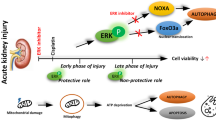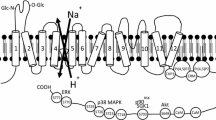Abstract
Objectives
We investigated the possible involvement of multidrug resistance protein 1 P-glycoprotein (MDR1 P-gp) in the oxalate-induced redistribution of phosphatidylserine in renal epithelial cell membranes.
Methods
Real-time PCR and western blotting were used to examine MDR1 expression in Madin–Darby canine kidney cells at the mRNA and protein levels, respectively, whereas surface-expressed phosphatidylserine was detected by the annexin V-binding assay.
Results
Oxalate treatment resulted in increased synthesis of MDR1, which resulted in phosphatidylserine (PS) externalization in the renal epithelial cell membrane. Treatment with the MDR1 inhibitor PSC833 significantly attenuated phosphatidylserine externalization. Transfection of the human MDR1 gene into renal epithelial cells significantly increased PS externalization.
Conclusions
To our knowledge, this study is the first to show that oxalate increases the synthesis of MDR1 P-gp, which plays a key role in hyperoxaluria-promoted calcium oxalate urolithiasis by facilitating phosphatidylserine redistribution in renal epithelial cells.




Similar content being viewed by others
References
Williamson P, Schlegel RA (2002) Transbilayer phospholipid movement and the clearance of apoptotic cells. Biochim Biophys Acta 1585(2–3):53–63
Schroit AJ, Zwaal RF (1991) Transbilayer movement of phospholipids in red cell and platelet membranes. Biochim Biophys Acta 1071(3):313–329
Contreras FX, Sanchez-Magraner L, Alonso A, Goni FM (2010) Transbilayer (flip–flop) lipid motion and lipid scrambling in membranes. FEBS Lett 584(9):1779–1786. doi:10.1016/j.febslet.2009.12.049
Devaux PF, Lopez-Montero I, Bryde S (2006) Proteins involved in lipid translocation in eukaryotic cells. Chem Phys Lipids 141(1–2):119–132. doi:10.1016/j.chemphyslip.2006.02.007
Khan SR (2013) Reactive oxygen species as the molecular modulators of calcium oxalate kidney stone formation: evidence from clinical and experimental investigations. J Urol 189(3):803–811. doi:10.1016/j.juro.2012.05.078
Tsujihata M (2008) Mechanism of calcium oxalate renal stone formation and renal tubular cell injury. Int J Urol 15(2):115–120. doi:10.1111/j.1442-2042.2007.01953.x
Thamilselvan S, Byer KJ, Hackett RL, Khan SR (2000) Free radical scavengers, catalase and superoxide dismutase provide protection from oxalate-associated injury to LLC-PK1 and MDCK cells. J Urol 164(1):224–229
Coe FL, Evan AP, Worcester EM, Lingeman JE (2010) Three pathways for human kidney stone formation. Urol Res 38(3):147–160. doi:10.1007/s00240-010-0271-8
Khan SR (2006) Renal tubular damage/dysfunction: key to the formation of kidney stones. Urol Res 34(2):86–91. doi:10.1007/s00240-005-0016-2
Cao LC, Jonassen J, Honeyman TW, Scheid C (2001) Oxalate-induced redistribution of phosphatidylserine in renal epithelial cells: implications for kidney stone disease. Am J Nephrol 21(1):69–77. doi:10.1159/000046224
Wiessner JH, Hasegawa AT, Hung LY, Mandel NS (1999) Oxalate-induced exposure of phosphatidylserine on the surface of renal epithelial cells in culture. J Am Soc Nephrol (JASN) 10(Suppl 14):S441–S445
Bigelow MW, Wiessner JH, Kleinman JG, Mandel NS (1997) Surface exposure of phosphatidylserine increases calcium oxalate crystal attachment to IMCD cells. Am J Physiol 272(1 Pt 2):F55–F62
Iida S, Ishimatsu M, Chikama S, Inoue M, Matsuoka K, Akasu T, Noda S, Khan SR (2003) Protective role of heparin/heparan sulfate on oxalate-induced changes in cell morphology and intracellular Ca2+. Urol Res 31(3):198–206. doi:10.1007/s00240-003-0317-2
Yu SL, Gan XG, Huang JM, Cao Y, Wang YQ, Pan SH, Ma LY, Teng YQ, An RH (2011) Oxalate impairs aminophospholipid translocase activity in renal epithelial cells via oxidative stress: implications for calcium oxalate urolithiasis. J Urol 186(3):1114–1120. doi:10.1016/j.juro.2011.04.106
Pohl A, Lage H, Muller P, Pomorski T, Herrmann A (2002) Transport of phosphatidylserine via MDR1 (multidrug resistance 1) P-glycoprotein in a human gastric carcinoma cell line. Biochem J 365(Pt 1):259–268. doi:10.1042/BJ20011880
Sugawara S, Hosono M, Ogawa Y, Takayanagi M, Nitta K (2005) Catfish egg lectin causes rapid activation of multidrug resistance 1 P-glycoprotein as a lipid translocase. Biol Pharm Bull 28(3):434–441
Gillet JP, Efferth T, Remacle J (2007) Chemotherapy-induced resistance by ATP-binding cassette transporter genes. Biochim Biophys Acta 1775(2):237–262. doi:10.1016/j.bbcan.2007.05.002
Efferth T (2001) The human ATP-binding cassette transporter genes: from the bench to the bedside. Curr Mol Med 1(1):45–65
Dean M, Hamon Y, Chimini G (2001) The human ATP-binding cassette (ABC) transporter superfamily. J Lipid Res 42(7):1007–1017
Jonsson B, Nilsson K, Nygren P, Larsson R (1992) SDZ PSC-833—a novel potent in vitro chemosensitizer in multiple myeloma. Anticancer Drugs 3(6):641–646
van Den Elsen JM, Kuntz DA, Hoedemaeker FJ, Rose DR (1999) Antibody C219 recognizes an alpha-helical epitope on P-glycoprotein. Proc Natl Acad Sci USA 96(24):13679–13684
Fojo AT, Ueda K, Slamon DJ, Poplack DG, Gottesman MM, Pastan I (1987) Expression of a multidrug-resistance gene in human tumors and tissues. Proc Natl Acad Sci USA 84(1):265–269
Coe FL, Evan A, Worcester E (2005) Kidney stone disease. J Clin Invest 115(10):2598–2608. doi:10.1172/JCI26662
Coe FL, Parks JH, Asplin JR (1992) The pathogenesis and treatment of kidney stones. N Engl J Med 327(16):1141–1152. doi:10.1056/NEJM199210153271607
Sarica K, Erturhan S, Altay B (2007) Effect of verapamil on urinary stone-forming risk factors. Urol Res 35(1):23–27. doi:10.1007/s00240-006-0075-z
Acknowledgments
This work was supported by the National Natural Science Foundation of China (Grant Number 81370803).
Author information
Authors and Affiliations
Corresponding author
Ethics declarations
Conflict of interest
Yu-Hang Li declares that he has no conflict of interest. Shi-Liang Yu declares that he has no conflict of interest. Xiu-Guo Gan declares that he has no conflict of interest. Shang-Ha Pan declares that he has no conflict of interest. Yue-Qiu Teng declares that she has no conflict of interest. Rui-Hua An declares that he has no conflict of interest.
Ethical approval
This article does not contain any studies with human participants or animals performed by any of the authors.
Rights and permissions
About this article
Cite this article
Li, YH., Yu, SL., Gan, XG. et al. Externalization of phosphatidylserine via multidrug resistance 1 (MDR1)/P-glycoprotein in oxalate-treated renal epithelial cells: implications for calcium oxalate urolithiasis. Int Urol Nephrol 48, 175–181 (2016). https://doi.org/10.1007/s11255-015-1155-1
Received:
Accepted:
Published:
Issue Date:
DOI: https://doi.org/10.1007/s11255-015-1155-1




